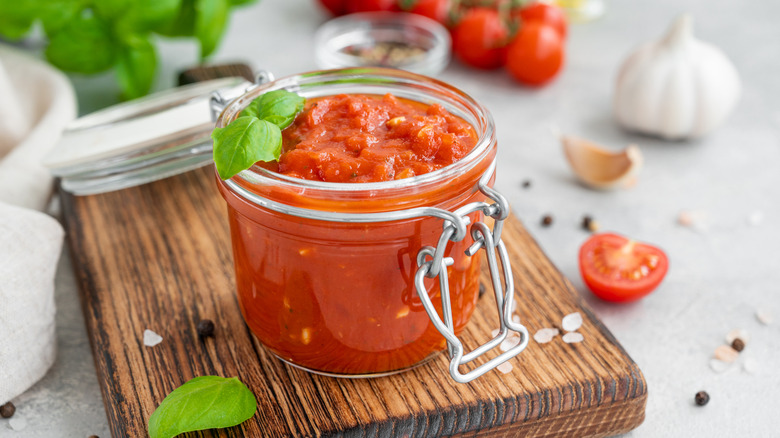How To Fix Overly Sweet Tomato Sauce Like A True Chef
One of the most disappointing feelings is making a meal and having it not come out quite right. After a long day at work, the last thing you want to do is start dinner over or wait for a food delivery after your first try didn't taste the way you wanted. This is especially true for pasta sauce. Maybe you attempted to make it yourself, and it didn't come out the way you intended, with too much sweetness that overpowers the other flavors. Maybe your store-bought jar had more sugar than you realized and it isn't to your taste, so you need to upgrade your tomato sauce. Maybe what it needs is some extra zip and zing from foods with plenty of salt and acidity.
When your tomato sauce comes out too sweet, not all hope is lost. There are a number of easy ways to balance out the sauce or alter the taste profile, meaning your time and food won't be wasted. One of the quickest and easiest of these is to add something acidic to the pot.
How to correct sweet tomato sauce using acid
There are a number of acids that can be used to fix overly-sweet tomato sauce, and you likely have at least one of them on hand. Lemons or lemon juice are commonly found in most refrigerators. On top of masking the sweetness in your sauce, they add a pleasant, vibrant fruit flavor that instantly elevates many dishes.
Red wine vinegar is another good choice, though Rachael Ray adds balsamic to her cherry tomato sauce. Robust Kitchen recommends an unconventional vinegary ingredient: mustard. Because mustard is acidic, it can tone down the sugar. Plus, it can add complexity of flavor to the sauce, which elevates the taste in addition to masking the sugariness in multiple ways.
If you're looking to simply enhance the natural acidity of the tomatoes without too much intervention, give cream of tartar a try. The odorless powder is a byproduct of the winemaking process and will help bring those tangy tastes tot the fore.
When adding acidic ingredients to your sauce, be sure to add just a bit at a time and taste as you go. You can add more if need be, but it is all too easy to overcorrect and make it too acidic. Don't worry about the extra liquid affecting the texture of the sauce — if it becomes too thin, simply simmer it until some of the water evaporates and it returns to the desired consistency.
Other ways to fix tomato sauce
If you don't have anything acidic on hand or are simply looking for new ways to impart different flavors in your sauce, there are other methods for correcting it when it's too sweet. One of the most obvious of these is to add salt if you don't mind increasing the sodium content, either with actual salt or with salty cheese like parmesan or pecorino. The other intuitive way to fix this issue is by diluting the sauce. For store-bought sauce, try diluting it with water, broth, canned tomato sauce, or something creamy, like heavy cream or plant-based milk. However, keep in mind this method will dilute the other flavors in the sauce. For homemade sauce, this is easier to do: simply add more of each ingredient besides the sweet one until you reach the desired taste profile.
Due to the drawbacks of each of these other methods, adding acid is the quickest and easiest way to transform your tomato sauce. The next time your homemade sauce doesn't come out as intended or your store-bought sauce leaves much to be desired, try this trick for a simple fix, saving you time and headache and permitting you to still enjoy your pasta.


